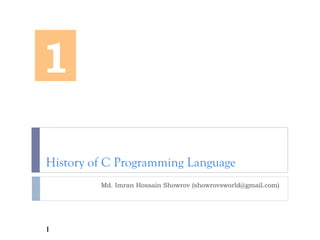Lecture 1- History of C Programming
•Transferir como PPT, PDF•
5 gostaram•1,528 visualizações
C Programming Language is the most popular computer language and most used programming language till now. It is very simple and elegant language. This lecture series will give you basic concepts of structured programming language with C.
Denunciar
Compartilhar
Denunciar
Compartilhar

Recomendados
Recomendados
Mais conteúdo relacionado
Mais procurados
Mais procurados (20)
Semelhante a Lecture 1- History of C Programming
Semelhante a Lecture 1- History of C Programming (20)
C Programming for Begineers_an introductory_course.pptx

C Programming for Begineers_an introductory_course.pptx
Introduction to c language | History of C language

Introduction to c language | History of C language
Mais de Md. Imran Hossain Showrov
Mais de Md. Imran Hossain Showrov (20)
Último
https://app.box.com/s/7hlvjxjalkrik7fb082xx3jk7xd7liz3TỔNG ÔN TẬP THI VÀO LỚP 10 MÔN TIẾNG ANH NĂM HỌC 2023 - 2024 CÓ ĐÁP ÁN (NGỮ Â...

TỔNG ÔN TẬP THI VÀO LỚP 10 MÔN TIẾNG ANH NĂM HỌC 2023 - 2024 CÓ ĐÁP ÁN (NGỮ Â...Nguyen Thanh Tu Collection
God is a creative God Gen 1:1. All that He created was “good”, could also be translated “beautiful”. God created man in His own image Gen 1:27. Maths helps us discover the beauty that God has created in His world and, in turn, create beautiful designs to serve and enrich the lives of others.
Explore beautiful and ugly buildings. Mathematics helps us create beautiful d...

Explore beautiful and ugly buildings. Mathematics helps us create beautiful d...christianmathematics
Último (20)
This PowerPoint helps students to consider the concept of infinity.

This PowerPoint helps students to consider the concept of infinity.
UGC NET Paper 1 Mathematical Reasoning & Aptitude.pdf

UGC NET Paper 1 Mathematical Reasoning & Aptitude.pdf
Food safety_Challenges food safety laboratories_.pdf

Food safety_Challenges food safety laboratories_.pdf
ICT role in 21st century education and it's challenges.

ICT role in 21st century education and it's challenges.
ICT Role in 21st Century Education & its Challenges.pptx

ICT Role in 21st Century Education & its Challenges.pptx
TỔNG ÔN TẬP THI VÀO LỚP 10 MÔN TIẾNG ANH NĂM HỌC 2023 - 2024 CÓ ĐÁP ÁN (NGỮ Â...

TỔNG ÔN TẬP THI VÀO LỚP 10 MÔN TIẾNG ANH NĂM HỌC 2023 - 2024 CÓ ĐÁP ÁN (NGỮ Â...
Unit-IV; Professional Sales Representative (PSR).pptx

Unit-IV; Professional Sales Representative (PSR).pptx
Python Notes for mca i year students osmania university.docx

Python Notes for mca i year students osmania university.docx
Explore beautiful and ugly buildings. Mathematics helps us create beautiful d...

Explore beautiful and ugly buildings. Mathematics helps us create beautiful d...
Mixin Classes in Odoo 17 How to Extend Models Using Mixin Classes

Mixin Classes in Odoo 17 How to Extend Models Using Mixin Classes
Lecture 1- History of C Programming
- 1. History of C Programming Language Md. Imran Hossain Showrov (showrovsworld@gmail.com) 1 1
- 2. Outline What is C Programing? Why C language is so Important? Origin of C Language History of C Language
- 3. What is C Programing? C is a high-level and general purpose programming language that is ideal for developing firmware or portable applications. Originally intended for writing system software, C was developed at Bell Labs by Dennis Ritchie for the Unix Operating System (OS) in the early 1970s.
- 4. Why C language is so Important? C language cases: Oracle is written in C Core libraries of android are written in C MySQL is written in C Almost every device driver is written in C Major Part of web browser is written in C Unix Operating system is developed in C C is the word’s most popular programming language
- 5. Why C language is so Important? (cont..) For a student point ofView: C is important to build programing skills. C covers basic features of all programming C is also helpful for Campus recruitment process C is the most popular language for hardware dependent programs
- 6. The Creator of C language Dennis MacAlistair Ritchie was an American computer scientist. He created the C programming language. He also created The Unix operating system with his long time colleague Ken Thompson. Dennis Ritchie 1941-2011 Father of C and UNIX
- 7. 1960 • ALGOL • International Group 1967 • BCPL • Martin Richards 1970 • B • Ken Thompson 1972 • Traditional C • Dennis Ritchie 1978 • K & R C • Brain Kernighan & Dennis Ritchie 1989 • ANSI C • ANSI Committee 1990 • ANSI/ISO C • ISO Committee Origin of C Language
- 8. Origin of C Language (cont..) BCPL and B are "type less" languages whereas C provides a variety of data types. In 1972 Dennis Ritchie at Bell Labs writes C and in 1978 the publication ofThe C Programming Language by Kernighan & Ritchie caused a revolution in the computing world.
- 9. History of C Language Evolved from two previous languages – BCPL, B BCPL (Basic Combined programming language) used for writing OS & compilers B used for creating early versions of UNIX OS Both are “typeless” language C language evolved from B (Dennis Ritchie – Bell labes)
- 10. Algol programming language Algol is a computer programming language Developed in 1958. Named for the algorithmic process of definition of a programming problem. Short for Algorithmic Language. Uses words to bracket blocks and was the first to use begin end pairs.
- 11. BCPL Full form: Basic Combined Programming Language. Developed in 1996. Developed by Martin Richards Its having high portability. BCPL is the successor to the CPL programming language.
- 12. B Developed in 1969 Designed by D. M. Ritchie and K. L.Thompson Developed at Bell Labs B was derived from BCPL Designed for primarily non-numeric applications.
Notas do Editor
- <number>